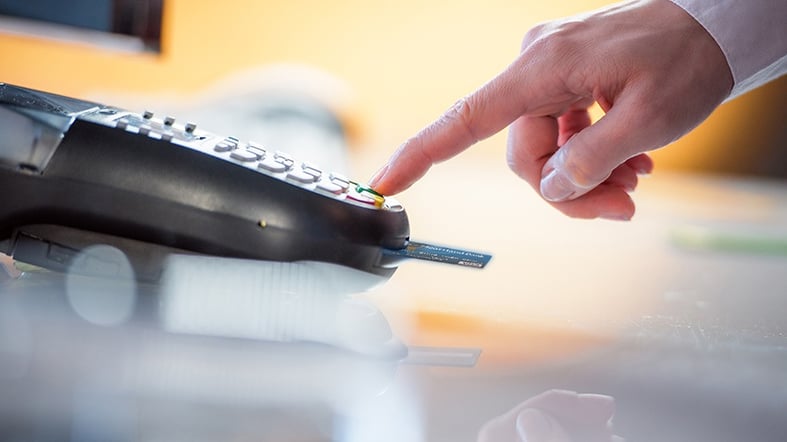 Americans report billions of dollars in credit and debit card fraud each year. A new technology using microprocessors called EMV chips could help curb future losses.
Americans report billions of dollars in credit and debit card fraud each year. A new technology using microprocessors called EMV chips could help curb future losses.
The chips are embedded on the front of credit and debit cards and exchange information with chip-card readers. Used together, the two make it harder for fraudsters to copy card information and make bogus in-store purchases.
Here's what you need to know about EMV cards.
If you have an EMV card, you'll insert the chipped end into a slot on an EMV-enabled reader, instead of swiping. Leave the card there for a few seconds, while the chip exchanges information with the payment processing system and authenticates the account; then remove it. Depending on the account, you might also sign for the purchase or enter a personal identification number, or PIN, to verify your identity and complete the sale.
Named for developers Europay, MasterCard and Visa, EMV chips encrypt your information and generate a unique code each time you use your card. Each code can be used only once — so they're useless to hackers.
Traditional cards use a magnetic strip that transmits the same unencrypted information every time you swipe. If someone copies the data, he or she can easily duplicate your plastic and use it to make fraudulent purchases.
EMV-enabled cards are already the standard in parts of Europe, Asia, Latin America and the Middle East. In the U.S., where credit and debit card fraud losses have risen steadily over the past few years, retailers and issuers are slowly catching up. Many issuers have sent new EMV cards to customers, and chip-card readers are becoming more common at stores across the U.S.
Banks, credit card companies and merchants in the U.S. picked up the pace of adoption last fall, when new fraud liability standards went into effect. Before Oct. 1, credit card issuers had borne the brunt of fraud losses, but responsibility now could fall to the retailer, if its system is less secure than the card used.
There's a good chance you've already received an EMV card. If you haven't, call your financial services provider and ask for one.
Using an EMV card at a retailer that has a chip-reading system should make your purchase more secure. It will also make it easier to use your card in the myriad of countries that already have the technology. Traditional cards can still be used most places too.
Although EMV technology helps you shop more safely, it doesn't thwart thieves entirely. Hackers can still pilfer your card information online or over the phone, or simply steal your card. So it's wise to exercise caution when using your credit or debit card. If your card goes missing or you spot suspicious activity, notify your financial institution immediately.
© Copyright 2016 NerdWallet, Inc. All Rights Reserved

This article was produced and provided by Nerdwallet. Nerdwallet gives consumers and small businesses clarity around all of life’s financial decisions. When it comes to credit cards, bank accounts, mortgages, loans or other expenses, consumers make almost all their decisions in the dark. NerdWallet is changing that, helping guide consumers' decisions with free expert content.
Due to recently increased security requirements, we at Heartland Bank are no longer able to support version 10 or older of Internet Explorer. We are sorry for this inconvenience, and encourage you to upgrade to more secure options such as Internet Explorer 11, Google Chrome, or Mozilla Firefox.

Over the past few years, the average federal tax refund has come to about $3,000. That's not exactly chump change. With the filing deadline approaching, it's not too early to begin thinking about how you'll use a refund this year. Here are five pointers to keep in mind.